


Digital cameras have revolutionized the way we capture moments and memories, offering an efficient and convenient way to take high-quality photos. These cameras use electronic sensors to capture images, replacing traditional film. They come in various shapes and sizes, offering a wide range of features to cater to different photography needs.
WiFi cameras, on the other hand, take digital photography a step further by enabling users to connect to the internet wirelessly. This connectivity allows for instant sharing of photos and videos on social media platforms or cloud storage services, making it easier to share moments with friends and family in real-time.
While both digital and WiFi cameras capture images electronically, the key difference lies in the connectivity aspect. Digital cameras store photos locally on memory cards, while WiFi cameras offer the convenience of online sharing and remote access. Understanding this difference can help you choose the right camera for your specific photography needs.
The Key Variations Between Digital and WiFi Cameras
When comparing digital cameras to WiFi cameras, there are several key differences that set them apart. Digital cameras refer to any camera that captures and stores images digitally, while WiFi cameras specifically have the ability to connect to wireless networks for easy sharing and remote access.
Functionality
One of the main differences between digital cameras and WiFi cameras is their functionality. Digital cameras are standalone devices that store images on memory cards or internal storage. On the other hand, WiFi cameras can connect to the internet wirelessly, allowing users to upload photos to the cloud, share them on social media, and even control the camera remotely using a smartphone or computer.
Connectivity
Another key difference is connectivity. Digital cameras typically require a physical connection, such as a USB cable, to transfer photos to a computer or other device. WiFi cameras, on the other hand, can transfer photos wirelessly over a WiFi network, making it much easier and more convenient to share images with others or backup photos to the cloud.
| Feature | Digital Camera | WiFi Camera |
|---|---|---|
| Storage | Memory cards or internal storage | Cloud storage |
| Transfer | Requires physical connection | Wireless transfer over WiFi network |
| Remote Access | No | Yes, via smartphone or computer |
Overview of Digital Cameras
Digital cameras, also known as digital cameras, are electronic devices that capture and store photographs digitally. Unlike traditional film cameras, digital cameras do not use film to record images but instead rely on electronic image sensors to capture pictures.
One of the key advantages of digital cameras is the ability to instantly view and edit photos on the camera’s display screen. This allows photographers to quickly assess their shots and make adjustments as needed. Digital cameras also offer the convenience of storing images on memory cards, eliminating the need for physical film.
Modern digital cameras come in a variety of shapes and sizes, from compact point-and-shoot models to advanced DSLR (digital single-lens reflex) cameras. They offer a range of features, including different resolutions, zoom capabilities, and shooting modes, catering to various levels of photography expertise.
Overall, digital cameras have revolutionized the way we capture and share images, making photography more accessible and versatile than ever before.
Overview of WiFi Cameras
WiFi cameras, also known as wireless cameras, are digital cameras that have the capability to connect to a Wi-Fi network. This allows users to remotely access and control the camera from their smartphone, tablet, or computer. WiFi cameras are popular for home security systems, baby monitors, and surveillance applications.
One key advantage of WiFi cameras is the convenience of wireless connectivity, which eliminates the need for physical cables and allows for flexible placement of the camera. Users can easily monitor their property or loved ones from anywhere with an internet connection.
WiFi cameras typically offer features such as motion detection, two-way audio communication, cloud storage, and night vision. Some models even support voice commands and integration with smart home devices for added functionality.
Overall, WiFi cameras provide a convenient and versatile solution for remote monitoring and surveillance, making them a popular choice for both residential and commercial applications.
Image Quality Comparison
When comparing the image quality between digital and WiFi cameras, several factors come into play.
Resolution
One of the key factors in image quality is resolution. Digital cameras typically offer higher resolution sensors compared to WiFi cameras, resulting in sharper and more detailed images.
Compression
Another factor to consider is the compression used in image processing. Digital cameras often have more advanced compression algorithms, leading to better image quality with smaller file sizes.
- Digital cameras: Better image quality with less compression artifacts.
- WiFi cameras: Lower image quality due to more aggressive compression.
Overall, digital cameras tend to offer superior image quality compared to WiFi cameras, especially in terms of resolution and compression.
Connectivity Options
One of the key differences between digital and WiFi cameras lies in their connectivity options. Digital cameras typically rely on physical connections, such as USB cables, to transfer photos and videos to a computer or other devices. This means that you need to physically connect the camera to a computer to transfer your files.
On the other hand, WiFi cameras come equipped with built-in WiFi connectivity, allowing you to wirelessly transfer your photos and videos to your smartphone, tablet, or computer. This wireless connection makes it much more convenient to share your images on social media platforms or with friends and family without the need for any cables.
Additionally, WiFi cameras often offer the ability to remotely control the camera from your smartphone or tablet, making it easier to capture photos and videos in different settings. This feature can be particularly useful for capturing group shots or selfies without needing to set a timer or rely on someone else to take the photo.
Storage and Sharing Features
Digital cameras typically come with built-in memory or support for memory cards, allowing users to store photos and videos directly on the camera. This provides a convenient way to access and transfer files without the need for a computer. Some digital cameras also offer cloud storage options, allowing users to back up their files online.
On the other hand, Wi-Fi cameras have the advantage of wireless connectivity, enabling users to easily share photos and videos directly from the camera to social media platforms or other devices. Wi-Fi cameras can also be set up to automatically transfer files to a computer or cloud storage service, making it easier to manage and organize content.
Remote Access and Control
One of the key differences between digital and Wi-Fi cameras is the ability to remotely access and control Wi-Fi cameras. With a Wi-Fi camera, you can connect to the camera wirelessly through a smartphone, tablet, or computer. This allows you to view live footage, adjust settings, and even capture photos or videos remotely.
On the other hand, digital cameras typically do not have built-in Wi-Fi connectivity, so you cannot access or control them remotely. You would need to physically interact with the camera to change settings or capture images.
Price Range and Affordability
When it comes to price, digital cameras and Wi-Fi cameras vary significantly. Digital cameras can be found in a wide range of prices, from budget-friendly options to high-end professional models. On the other hand, Wi-Fi cameras tend to be more expensive due to their advanced connectivity features. The price difference is mainly attributed to the additional technology and capabilities that Wi-Fi cameras offer.
For those on a budget, digital cameras may be a more affordable option, especially for beginners or casual photographers. However, if you value the convenience and flexibility of wirelessly transferring and sharing your photos, investing in a Wi-Fi camera might be worth the higher cost.
Usage Scenarios
When it comes to usage scenarios, both digital and Wi-Fi cameras offer unique advantages.
Digital Camera
A digital camera is ideal for photographers who prefer a traditional approach to photography and want full control over their camera settings. It is perfect for capturing high-quality images in various lighting conditions and allows for manual adjustments such as aperture, shutter speed, and ISO. Digital cameras are also great for professional photographers who require maximum image quality and flexibility in post-processing.
Wi-Fi Camera
On the other hand, a Wi-Fi camera is perfect for users who want instant connectivity and seamless sharing of photos and videos. With built-in Wi-Fi capabilities, these cameras allow you to transfer images wirelessly to your smartphone, tablet, or computer, making it easy to share your moments on social media or with friends and family. Wi-Fi cameras are great for travelers, bloggers, and social media influencers who need to quickly upload and share their content online.
| Feature | Digital Camera | Wi-Fi Camera |
|---|---|---|
| Control Over Settings | Full manual control | Basic settings control |
| Connectivity | Usually requires a cable for transfer | Wireless transfer via Wi-Fi |
| Sharing Options | Manual transfer to computer or device | Instant sharing to social media platforms |
FAQ
What is the main difference between digital and wifi cameras?
The main difference between digital and wifi cameras is that digital cameras capture and store photos and videos on a memory card, while wifi cameras can connect to a wireless network to transfer images directly to a smartphone, computer, or cloud storage without the need for physical storage media.
How do digital cameras work compared to wifi cameras?
Digital cameras use memory cards to store photos and videos locally, while wifi cameras have the capability to connect to a wireless network and transfer images wirelessly to other devices or online platforms. This allows wifi cameras to share images instantly without the need for physical transfer.
Can you explain the advantages of using a wifi camera over a traditional digital camera?
One of the main advantages of using a wifi camera is the ability to instantly share photos and videos wirelessly to other devices or online platforms. This eliminates the need for physical transfer of files and allows for quick and convenient sharing of images. Additionally, wifi cameras often come with advanced features like remote control and live streaming capabilities.
Are there any disadvantages of using a wifi camera instead of a digital camera?
One potential disadvantage of using a wifi camera is the dependency on a stable wireless network for transferring images. In areas with poor wifi connectivity, the transfer speed may be slow or unreliable. Additionally, wifi cameras tend to consume more battery power compared to traditional digital cameras due to the continuous wireless connection.







